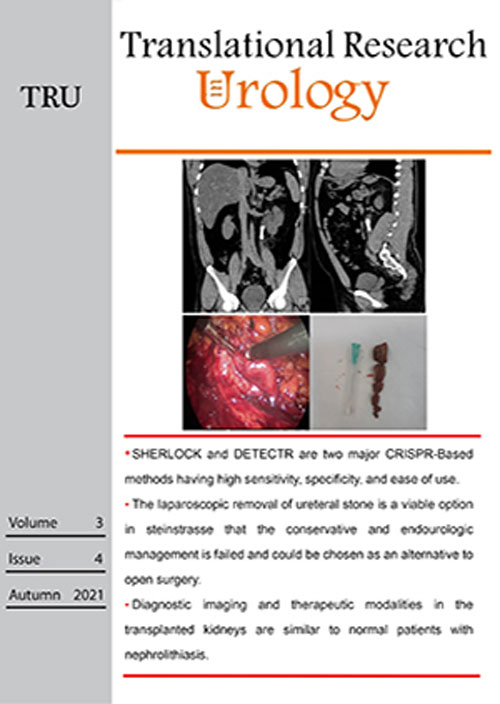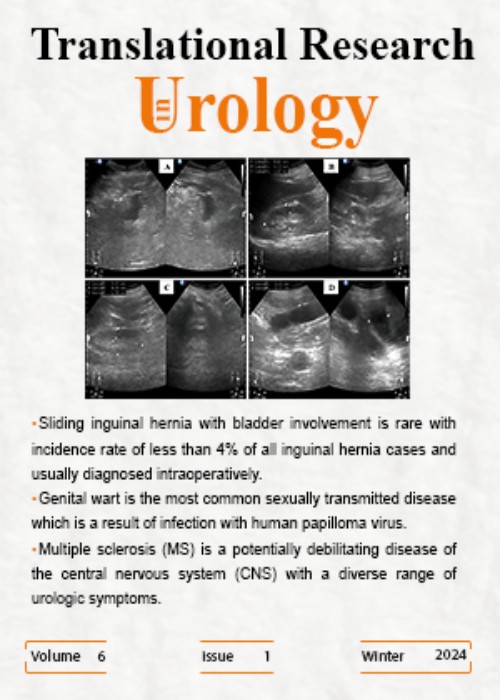فهرست مطالب

Journal of Translational Research in Urology
Volume:3 Issue: 4, Autumn 2021
- تاریخ انتشار: 1400/09/30
- تعداد عناوین: 8
-
-
Pages 143-145
Rapid and accurate detection of nucleic acids is essential in many fields of modern biology and medical diagnosis of pathogens. PCR has some disadvantages for performing this task, and therefore demand for an alternative is highly appreciated. Recently, CRISPR-Cas systems have been introduced as a rapid, sensitive, and efficient method for nucleic acid detection. This editorial article reviews mechanisms of action and preclinical results of SHERLOCK and DETECTR as two significant forms of CRISPR-Cas systems for nucleic acid detection.
Keywords: CRISPR, SHERLOCK, DETECTR -
Pages 146-148Introduction
The steinstrasse or stone street is a rare complication after Shock wave lithotripsy (SWL). The true incidence is unknown but is mentioned between 1-4 % in stone size less than 2 cm to 13% in large stone.
Case presentationwe present a 37-year-old man with a proximal ureter steinstrasse. He was managed with laparoscopic ureterolithotomy as the SWL failed, and also, ureteroscopic access to the upper ureter failed due to the ureteral stenosis.
ConclusionThe laparoscopic removal of ureteral stone is a viable option in steinstrasse that the conservative and endourologic management is failed and could be chosen as an alternative to open surgery.
Keywords: Shock Wave Lithotripsy, Ureteral Stone, Steinstrasse, Laparoscopic Ureterolithotomy -
Pages 149-153
Urolithiasis is rare in renal transplant patients (<1%). The reasons are multifactorial such as metabolic, medications, and recurrent urinary tract infections. The stones are usually found incidentally on imaging; 50% of these patients are asymptomatic. In some patients’ recurrent urinary tract infection (UTI), hematuria, fever, oliguria, or anuria are presenting symptoms. The local pain on the graft may be the only sign. Diagnostic imaging and therapeutic modalities are similar to normal patients with nephrolithiasis. A high index of clinical suspicion is needed for timely diagnosis of urolithiasis in transplant kidneys and early intervention seems crucial. The common therapeutic modalities are the same as the normal patients with urolithiasis.
Keywords: renal transplant, urolithiasis, Percutaneous nephrolithotomy, Ureteroscopy, Shock Wave Lithotripsy -
Pages 154-160Introduction
Percutaneous nephrolithotomy (PNL) is widely used for kidney stones. One of the complications of PNL is Systemic inflammatory response syndrome (SIRS), which is of great importance. Here we wanted to estimate the effectiveness of neutrophil to lymphocyte ratio (NLR) and platelet-to-lymphocyte ratio (PLR) in predicting SIRS following PNL.
MethodsThis study is prospective observational work done in 2018-2019 in Isfahan, Iran, on patients diagnosed with kidney stones that were candidates of PNL. We collected patient demographic data, including gender, age, and size of kidney stones. Information about the operation duration, procedures, and laboratory data were collected before and after the procedures. All data were compared between patients with or without SIRS after PNL.
ResultsIn the present study, 152 candidates for PNL entered the research. The average age of the patients was 52.1± 13.4 years. In this study, 95 patients (62.5%) were male, and 57 (37.5%) were female. The average stone size was 29.4± 5.3 mm. Based on our data; 26 patients (17.1%) had sepsis after the procedure. There was only a significant difference between groups of patients regarding primary stone composition in the way that 92.3% of cases with sepsis had two stone compositions while 44.4% of other patients had two stone compositions and 50% had one stone composition (P-value<0.001). We found that patients that had sepsis after PNL had significantly higher operation duration (P-value=0.044) and significantly higher packed cell transfusion (30.8%) compared to other patients (4%) (P-value<0.001). The NLR below 72.2 could predict sepsis after PNL with 80.5% sensitivity and 33.3% specificity. Furthermore, the PLR below 63.3 could predict sepsis after PNL with 90.9% sensitivity and 5.3% specificity.
ConclusionElevated NLR and PLR are associated with increased frequencies of SIRS after PNL. These data could be used effectively in predicting SIRS in these patients.
Keywords: Systemic inflammatory response syndrome, Percutaneous nephrolithotomy, neutrophil to lymphocyte ratio, platelet-to-lymphocyte ratio -
Pages 161-169IntroductionPeyronie's disease (PD) is penile and may present with penile pain curvature, shortening, and plaque in the penis and erectile dysfunction (ED) in some cases. This study assesses the efficacy of vacuum therapy and massagor in patients with PD at the acute phase. The basic principle of the study is similar to modeling performed during penile implant surgery.MethodsThis study was performed on 200 Patients with Peyronie's disease in the acute phase who were referred to the family health clinic of shahed university. Patients were trained to practice with three different sized and shaped vacuum cylinders in addition to mini vibrating massagor for 30 minutes, three times a day for three months. They used the smallest curve cylinder (being used in the opposite direction of penile curvature) in the first and the second, respectively, followed by using the most oversized cylinder and bending the penis toward the opposite direction. In contrast, placing a constrictive ring at the base of the penis in the third month and massagor is used intermittently. Parameters were recorded before the beginning of the study and at the end of each month. Assessment includes pain during erection, number and size of the plaque, curvature of penile, quality of an erection, and penile shortening.ResultsA total of 200 patients with a mean age of (17-70) years participated in the study. At the presentation, the mean of plaque size and curvature was 1.21 ± 1.21 cm and 51.62 degrees, respectively, which were reduced to 0.74 ± 1.01 cm. and 31.87 degrees, respectively at the end of the study.ConclusionThe use of newly shaped and sized vacuum pumping and the massagor is an effective method in treating Peyronie's disease in the acute phase and can significantly reduce pain, curvature, plaque size, and increase erectile function.Keywords: Peyronie’s Disease, penile curvature, penile plaque, Vacuum Therapy, Acute Phase, Conservative Therapy
-
Pages 170-175IntroductionErectile dysfunction (ED) is a common problematic disease in spinal cord injured patients. The effect of this disease on the life quality in patients has been well stated. Therefore, this study examined the impact of the vacuum constrictive device (VCD).MethodsThe total number of sixty patients with spinal cord injury (SCI) were recruited at different levels of the spinal column, complaining of ED, who had not shown a positive response to sildenafil. Based on the international index of erectile function (IIEF) and single questioning patient's partner regarding the man's ability to perform vaginal penetration (APVP), the diagnosis of ED and treatment efficacy were evaluated.ResultsThe mean age was 29.2±5.31 years old. It significantly improved the IIEF score between two target groups of pre-treatments (7.86±1.38) and post-treatment (24.41±4.70). IIEF scores of patients with APVP positive were signed (p<0.001) improved between pre-treatment (7.95±1.38) and post-treatment (26.35±2.26). Final 48 had successful sexual intercourse, and 12 patients needed accessory treatments due to spouse virginity.ConclusionA vacuum constrictive device could be suggested as a suitable second-line of ED due to spinal cord injury. The VCD is effective in many spinal cords injured patients with erectile dysfunction. The devices were not accepted by any patients but significantly affected sexual function and sexual satisfaction. Vacuum constrictive is a choice of treatment in SCI men, along with other options for treatment of erectile dysfunction.Keywords: Erectile Dysfunction, Spinal cord injury, Vacuum constrictive device, virginity
-
Pages 176-181IntroductionNephrolithiasis is one of the most common prevalent diseases in the human population, with a high recurrence rate. Although the prophylaxis effect of potassium citrate in renal calculi is well known, its therapeutic effect of melting kidney stones is not well-understood. This study aims to evaluate the therapeutic effect of potassium citrate on rats with nephrolithiasis.MethodsThirty, 4 to 6-week-old, male and female Wistar rats weighing 200±11 g were studied. After a one-week acclimatization period, the rats were randomly assigned into three groups using a computer-generated randomization list: Group A (control group), Group B (ethylene glycol receivers), Group C (treatment group) for four weeks. For further pathologic examinations of the urinary system, two rats, including a male and a female, were randomly selected from each group and were sacrificed. Their urinary system, including kidneys, ureters, bladder, and urethra, was extracted for pathology and serologic examinations.ResultsThe ethylene glycol group demonstrated Bowman's capsule hemorrhage and glomeruli size decrement in microscopic examination compared to control subjects. Although the changes were present in the mice of simultaneous exposure to Potassium Citrate and ethylene glycol, their extent was much less in the treatment group.ConclusionAlthough histopathologic studies suggested that potassium citrate may prevent rat ethylene glycol in stone formation, radiologic examinations were inconclusive.Keywords: Potassium Citrate, Nephrolithiasis, animal study, Ethylene glycol
-
Pages 182-190IntroductionThe role of serum neutrophil gelatinase-associated lipocalin (NGAL) in predicting delayed graft function (DGF) after kidney transplantation is poorly defined. The objective of this study was to evaluate the serum NGAL expression in the early postoperative phase after kidney transplantation and compare it with serum creatinine (Cr).MethodsWe studied 29 patients who received kidney transplantation from deceased (n=24) and lived (n=5) donors from October 2017 to December 2018 at the Urology Research Center, Sina Hospital, Tehran University of Medical Sciences, Tehran, Iran. Serum NGAL, Serum Cr, and urine output were measured at 1 to 7 days after transplantation. The need for dialysis in one week after transplantation was evaluated.ResultsAmong 29 recipients with serum biomarkers measurements, 8 (27.5%) developed DGF (need to hemodialysis within one week of transplantation). Resulted in areas under ROC curves (AUCs) for serum NGAL at early hours following transplantation was (0.839, 95% CI: 0.69-0.98, P-value=0.005) that could accurately predict DGF compared to urine output (0.747, 95% CI: 0.55-0.93, P-value=0.045) and serum Cr (0.607, 95% CI: 0.34-0.86, P-value=0.398) at 24 hours after transplantation. Multivariate analysis revealed that only serum NGAL was a significant independent predictor of DGF (OR: 0.996, 95% CI: 0.993-1.000, P-value=0.039).ConclusionSerum NGAL at early hours of post-transplantation was a valuable biomarker for an early accurate predictor of DGF in kidney transplantation compared with traditional biomarkers such as serum Cr and urine output.Keywords: Kidney Transplantation, delay graft function, serum NGAL, predictive biomarkers


